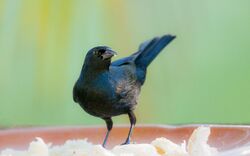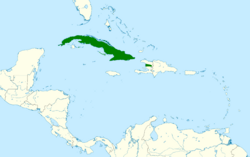Biology:Tawny-shouldered blackbird
| Tawny-shouldered blackbird | |
|---|---|

| |
| Scientific classification | |
| Domain: | Eukaryota |
| Kingdom: | Animalia |
| Phylum: | Chordata |
| Class: | Aves |
| Order: | Passeriformes |
| Family: | Icteridae |
| Genus: | Agelaius |
| Species: | A. humeralis
|
| Binomial name | |
| Agelaius humeralis (Vigors, 1827)
| |
| Subspecies | |
|
Agelaius humeralis humeralis | |

| |
| Range of A. humeralis (note: map is missing distribution in the Dominican Republic) | |
The tawny-shouldered blackbird (Agelaius humeralis) is a species of bird in the family Icteridae. It is found in Cuba and Hispaniola (split between the Dominican Republic and Haiti). It is a vagrant in the United States (to the Florida Keys).
Description
Measuring 20 cm (7.9 in) long, this highly social species is entirely black, save for the namesake brown-orange patch at the shoulder. The patch may not be visible when the wings are folded.[2]
Taxonomy
Two subspecies are described:[3]
- A. h. humeralis – (Vigors, 1827): nominate, found in Cuba and Hispaniola
- A. h. scopulus – Garrido, 1970: found on Cayo Cantiles (east of Isla de la Juventud off southwestern Cuba)
Breeding
They breed from April to August, laying 3–4 greenish-white eggs spotted with brown in a cup-shaped nest that is lined with soft materials and placed in a tree.[2]
Diet and habitat
Tawny-shouldered blackbirds eat insects, seeds, nectar, fruit, and small lizards.[2] Its natural habitats are subtropical or tropical dry shrubland, pastureland, and heavily degraded former forest.
References
- ↑ BirdLife International (2018). "Agelaius humeralis". IUCN Red List of Threatened Species 2018: e.T22724206A132028704. doi:10.2305/IUCN.UK.2018-2.RLTS.T22724206A132028704.en. https://www.iucnredlist.org/species/22724206/132028704. Retrieved 13 November 2021.
- ↑ 2.0 2.1 2.2 Garrido, Orlando H.; Kirkconnell, Arturo (2000). Field Guide to the Birds of Cuba. Ithaca, NY: Comstock, Cornell University Press. pp. 219–220. ISBN 978-0-8014-8631-9.
- ↑ Gill, F.; Donsker, D., eds (2014). "IOC World Bird List". IOC World Bird List (V 4.2). doi:10.14344/IOC.ML.4.2. http://www.worldbirdnames.org.
External links
- BirdLife species factsheet for Agelaius humeralis
- "Agelaius humeralis". Avibase. https://avibase.bsc-eoc.org/species.jsp?lang=EN&avibaseid=.
- "Tawny-shouldered blackbird media". Internet Bird Collection. http://www.hbw.com/ibc/species/tawny-shouldered-blackbird-agelaius-humeralis.
- Tawny-shouldered blackbird photo gallery at VIREO (Drexel University)
Wikidata ☰ Q890897 entry
 |


